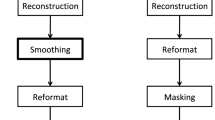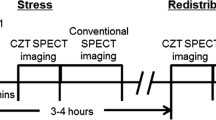Abstract
Objectives
The currently available Japanese normal database (NDB) in stress myocardial perfusion scintigraphy recommended by the Japanese Society of Nuclear Medicine (JSNM-NDB) is created based on the data from exercise tests. The newly developed adenosine normal database (ADS-NDB) remains to be validated for patients undergoing adenosine stress test. We tested whether the diagnostic accuracy of adenosine stress test is improved by the use of ADS-NDB (Kanazawa University).
Methods
Of 233 consecutive patients undergoing 99mTc-MIBI adenosine stress test, 112 patients were tested. The stress/rest myocardial 99mTc-MIBI single-photon emission computed tomography (SPECT) images were analyzed by AutoQUANT 7.2 with both ADS-NDB and JSNM-NDB. The summed stress score (SSS) and summed difference score (SDS) were calculated. The agreements of the post-stress defect severity between ADS-NDB and JSNM-NDB were assessed using a weighted kappa statistic.
Results
In all patients, mean SSSs of all, right coronary artery (RCA), left anterior descending (LAD), and left circumflex (LCx) territories were significantly lower with ADS-NDB than those with JSNM-NDB. Mean SDSs in all, RCA, and LAD territories were significantly lower with ADS-NDB than those with JSNM-NDB. In 28 patients with significant coronary stenosis, the mean SSS in the RCA territory was significantly lower with ADS-NDB than that with JSNM-NDB. In 84 patients without ischemia, both mean SSSs and SDSs in all, RCA, LAD, and LCx territories were significantly lower with ADS-NDB than those with JSNM-NDB. Weighted kappa values of all patients, patients with significant stenosis, and patients without ischemia were 0.89, 0.83, and 0.92, respectively.
Conclusions
Differences were observed between results from ADS-NDB and JSNM-NDB. The diagnostic accuracy of adenosine stress myocardial perfusion scintigraphy may be improved by reducing false-positive results.





Similar content being viewed by others

References
Hachamovitch R, Berman DS, Kiat H, Cohen I, Cabico JA, Friedman J, et al. Exercise myocardial perfusion SPECT in patients without known coronary artery disease: incremental prognostic value and use in risk stratification. Circulation. 1996;93:905–14.
Berman DS, Hachamovitch R, Kiat H, Cohen I, Cabico JA, Wang FP, et al. Incremental value of prognostic testing in patients with known or suspected ischemic heart disease: a basis for optimal utilization of exercise technetium-99 m sestamibi myocardial perfusion single-photon emission computed tomography. J Am Coll Cardiol. 1995;26:637–47.
Leppo JA. Comparison of pharmacologic stress agents. J Nucl Cardiol. 1996;3:S22–6.
Nakajima K, Kumita S, Ishida Y, Momose M, Hashimoto J, Morita K, et al. Creation and characterization of Japanese standards for myocardial perfusion SPECT: database from the Japanese Society of Nuclear Medicine Working Group. Ann Nucl Med. 2007;21:505–15.
Okuda K, Nakajima K, Ishikawa T, Ichikawa K, Matsuo S, Taki J, et al. Quantitative comparison of stress myocardial perfusion SPECT between exercise and pharmacological stress. Japanese Journal of Nuclear Medicine (Kaku Igaku) 2013;50:P187 (Abstract).
Matsuo S, Nakajima K, Horie M, Nakae I. Nishimura T; J-ACCESS Investigators. Prognostic value of normal stress myocardial perfusion imaging in Japanese population. Circ J. 2008;72:611–7.
Germano G, Kavanagh PB, Waechter P, Areeda J, Van Kriekinge S, Sharir T, et al. A new algorithm for the quantitation of myocardial perfusion SPECT. I: technical principles and reproducibility. J Nucl Med. 2000;41:712–9.
Sharir T, Germano G, Waechter PB, Kavanagh PB, Areeda JS, Gerlach J, et al. A new algorithm for the quantitation of myocardial perfusion SPECT. II: validation and diagnostic yield. J Nucl Med. 2000;41:720–7.
Germano GJ, Germano G, Kiat H, Kavanagh PB, Moriel M, Mazzanti M, et al. Automatic quantification of ejection fraction from gated myocardial perfusion SPECT. J Nucl Med. 1995;36:2138–47.
Berman DS, Abidov A, Kang X, Hayes SW, Friedman JD, Sciammarella MG, et al. Prognostic validation of a 17-segment score derived from a 20-segment score for myocardial perfusion SPECT interpretation. J Nucl Cardiol. 2004;4:14–23.
Garcia EV, Faber TL, Cooke CD, Folks RD, Chen J, Santana C. The increasing role of quantification in clinical nuclear cardiology: the Emory approach. J Nucl Cardiol. 2007;14:420–32.
Ficaro EP, Lee BC, Kritzman JN, Corbett JR. Corridor4DM: the Michigan method for quantitative nuclear cardiology. J Nucl Cardiol. 2007;14:455–65.
Germano G, Kavanagh PB, Slomka PJ, Van Kriekinge SD, Pollard G, Berman DS. Quantitation in gated perfusion SPECT imaging: the Cedars-Sinai approach. J Nucl Cardiol. 2007;14:433–54.
Nakajima K, Okuda K, Kawano M, Matsuo S, Slomka P, Germano G, et al. The importance of population-specific normal database for quantification of myocardial ischemia: comparison between Japanese 360 and 180-degree databases and a US database. J Nucl Cardiol. 2009;16:422–30.
Knollmann D, Knebel I, Koch KC, Gebhard M, Krohn T, Buell U, et al. Comparison of SSS and SRS calculated from normal databases provided by QPS and 4D-MSPECT manufacturers and from identical institutional normals. Eur J Nucl Med Mol Imaging. 2008;35:311–8.
Mester J, Weller R, Clausen M, Bitter F, Henze E, Lietzenmayer R, et al. Upward creep of the heart in exercise thallium 201 single photon emission tomography: clinical relevance and a simple correction method. Eur J Nucl Med. 1991;18:184–90.
Matsumoto N, Berman DS, Kavanagh PB, Gerlach J, Hayes SW, Lewin HC, et al. Quantitative assessment of motion artifacts and validation of a new motion-correction program for myocardial perfusion SPECT. J Nucl Med. 2001;42:687–94.
Boden WE, O’Rourke RA, Teo KK, Hartigan PM, Maron DJ, Kostuk WJ, et al. COURAGE Trial Research Group. Optimal medical therapy with or without PCI for stable coronary disease. N Engl J Med. 2007;356:1503–16.
Shaw LJ, Berman DS, Maron DJ, Mancini GB, Hayes SW, Hartigan PM, et al. COURAGE Investigators Optimal medical therapy with or without percutaneous coronary intervention to reduce ischemic burden: results from the Clinical Outcomes Utilizing Revascularization and Aggressive Drug Evaluation (COURAGE) trial nuclear substudy. Circulation. 2008;117:1283–91.
Nishimura T, Nakajima K, Kusuoka H, Yamashina A, Nishimura S. Prognostic study of risk stratification among Japanese patients with ischemic heart disease using gated myocardial perfusion SPECT: J-ACCESS study. Eur J Nucl Med Mol Imaging. 2008;35:319–28.
Hachamovitch R, Berman DS, Shaw LJ, Kiat H, Cohen I, Cabico JA, et al. Incremental prognostic value of myocardial perfusion single photon emission computed tomography for the prediction of cardiac death: differential stratification for risk of cardiac death and myocardial infarction. Circulation. 1998;97:535–43.
Acknowledgments
We thank the radiological technicians of radiology department, Ogaki Municipal Hospital, Masakazu Furukawa, Fumihiko Niwa, Hirozumi Nishiwaki, for the technical assistance of scintigraphy examination.
Author information
Authors and Affiliations
Corresponding author
Ethics declarations
Conflict of interest
The authors declare that they have no conflicts of interest.
Additional information
S. Harata and S. Isobe equally contributed this study and shared the first author.
Rights and permissions
About this article
Cite this article
Harata, S., Isobe, S., Morishima, I. et al. Application of the newly developed Japanese adenosine normal database for adenosine stress myocardial scintigraphy. Ann Nucl Med 29, 730–739 (2015). https://doi.org/10.1007/s12149-015-0995-1
Received:
Accepted:
Published:
Issue Date:
DOI: https://doi.org/10.1007/s12149-015-0995-1



